Ensuring Safety and Sustaining Efficiency: Scaffold and Mast Climbing Work Platforms
Words: Clint Bridges
Words and Photos: Clint Bridges, Vice President of EZ Scaffold
According to OSHA, 65% of all construction workers will be on a scaffold this year. In the masonry trade, it is closer to 100%. Annually, scaffolding is in the top five of construction accidents, which probably makes it the number one cause of injury in the masonry industry. I read somewhere/sometime that 99% of all scaffold accidents are due to user failure (With 30 years of being in the scaffold industry, I have read a lot so I am a wealth of unsupported but meaningful statistics!). While 99% may be excessive, when you consider how much of the human element is involved with scaffolding, it’s easy to understand why it is the major reason for scaffold accidents. If it is set up correctly and used correctly, it is not coming down. Fortunately, the human element is also the best way to prevent scaffold accidents. The construction industry has made great strides in improving training and job site inspections when it comes to scaffolding. Maintenance, however, has not made the same strides. While some companies have great maintenance programs, most maintain by fire, which, when it pertains to scaffolding, is not only expensive but dangerous.
Although this article focuses on what EZ Scaffold manufactures, Crank Up Scaffold (CU) and Mast Climbing Work Platforms (MCWP), it can be applied to other types of supported scaffold with similar characteristics. Also, each manufacturer is different. You will need to get training and guidance from the specific manufacturer of the equipment you are using.
Universal Scaffold
There are certain things that are similar to every scaffold: structure, fasteners and scaffold plank. Inspect the structure for damage and corrosion. A bent piece of steel may still be structurally sound if it is smooth. Tears, kinks and cracked welds are what we are looking for (Figure 1). Structural members with smooth bends that prevent the scaffold from being plum should also be removed from service (Figure 2).
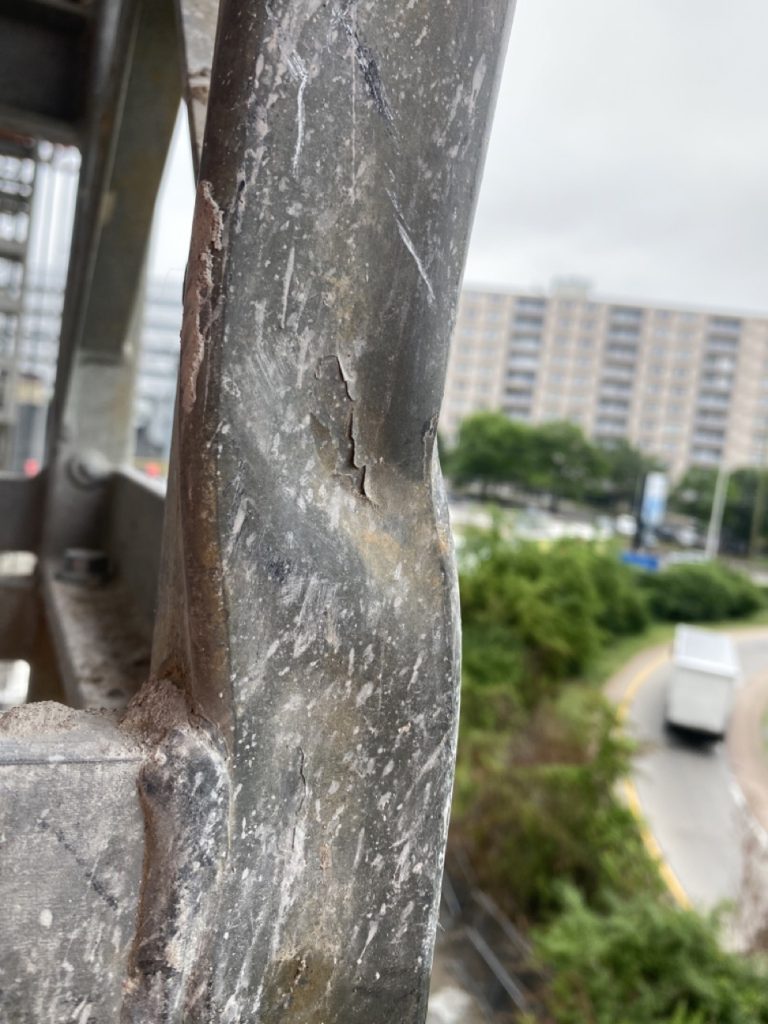 Figure 1A
Figure 1A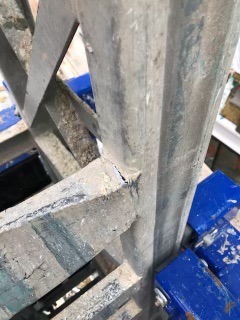 Figure 1B
Figure 1B
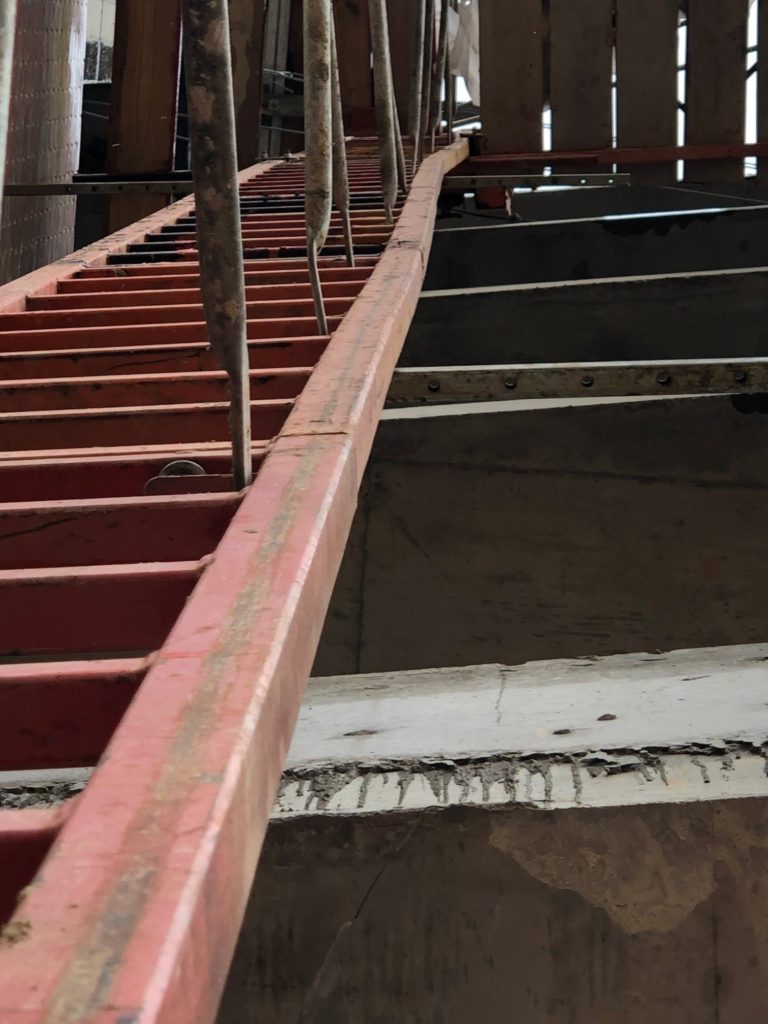 Figure 2
Figure 2Structure
Corrosion (Figure 3) has become a hot topic, as it should be, in recent years. This should probably be the topic of an article by itself. Accidents due to corrosion have brought this to the forefront. Some manufacturers have developed a policy for inspection, some including ultrasonic thickness testing. It is important that you follow your manufacturer’s ultrasonic testing requirements and document retention. While these guidelines should be worked into an inspection/maintenance program, I have yet to see a structural member that didn’t pass that wasn’t obvious to the naked eye or members with interior structural corrosion that didn’t have exterior corrosion. The moral of this lesson is that a structural member that is corroded to the point that it doesn’t meet the manufacturer's specifications will be visible to a qualified person and probably everyone else.
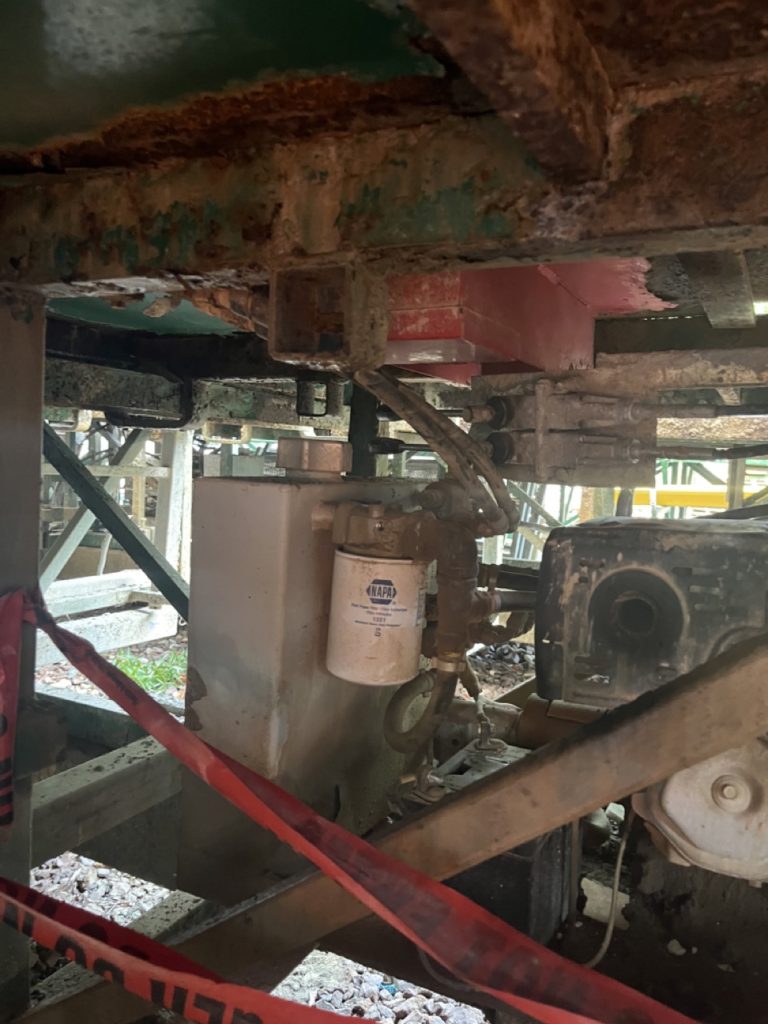 Figure 3
Figure 3Fasteners
Fasteners: nuts, bolts, pins, etc., should be inspected prior to each use. Fasteners should be free from defects, free from corrosion and work as designed. Nuts and bolts should easily start by hand. Cross threaded nuts and bolts should never be used. Use corrosion resistant coatings where required by the manufacturer. If fasteners are to be replaced, they should be replaced with an identical component. If an identical fastener is not available but a similar one is, get permission from the manufacturer IN WRITING. Not only does getting it in writing cover you if something happens, it confirms that there is no misunderstanding.
Scaffold Plank
Scaffold plank is a huge issue. It is the primary cause of injuries to workers due to scaffolding accidents. There are lots of other forms, but scaffold plank is still the primary work platform surface in the masonry industry. I don’t know why people look at a board and scratch their head whether it is good enough to use. This is one of those instances, when in doubt, throw it out (or make it a mud sill)! I knew of a superintendent on a job site that fell 40’ when the scaffold plank he was standing on broke in half. There was no other weight on the scaffold plank, just the superintendent. How bad does a scaffold plank have to be that you can’t even stand on it? Some requirements when inspecting boards:
1. Cannot deflect more than 1/60th of the span under it’s designed load
- DI65 scaffold plank with a 7’ span cannot deflect more that 1.4” with man + tools weighing 250 lbs located at span
2. Plank with end splits longer than the width of the plank must be removed (Figure 4).
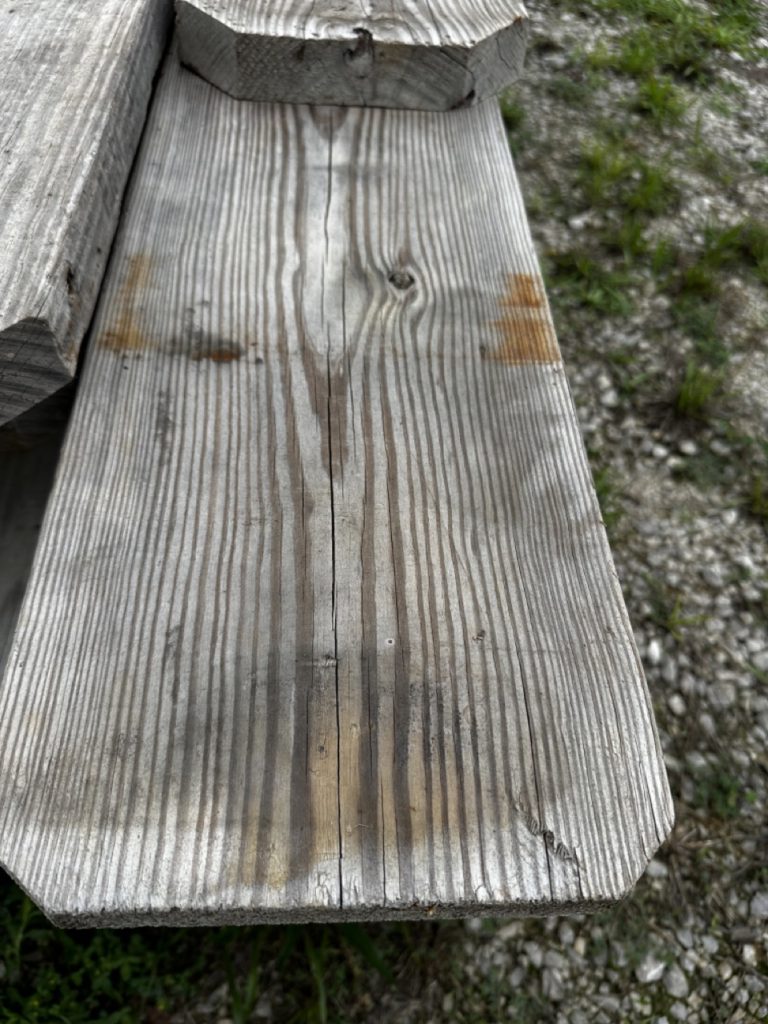 Figure 4
Figure 4- End splits equal to or less than the width of the plank may be banded to prevent further propagation.
3. Narrow face splits are not allowed. Remove from service (Figure 4A)
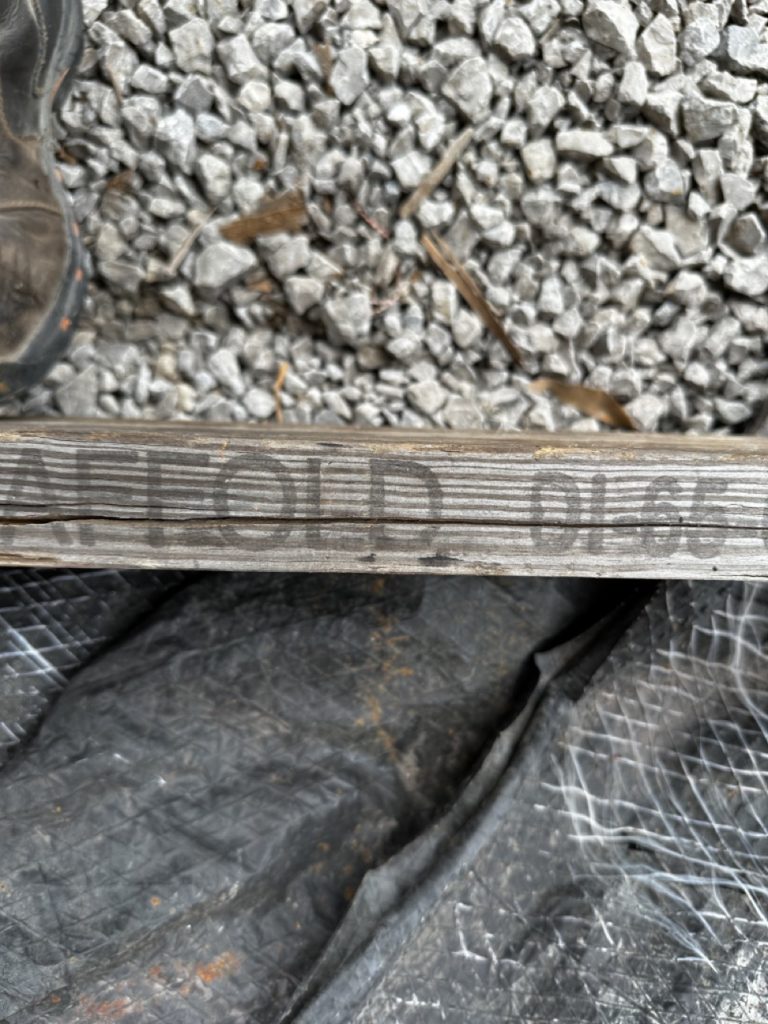 Figure 4A
Figure 4A4. Delamination in laminated planks is not allowed. Remove from service
5. Damage from forklifts, dropping, etc. is not allowed without review of a qualified person.
6. Saw cuts are not allowed. Remove from service. (Figure 4B)
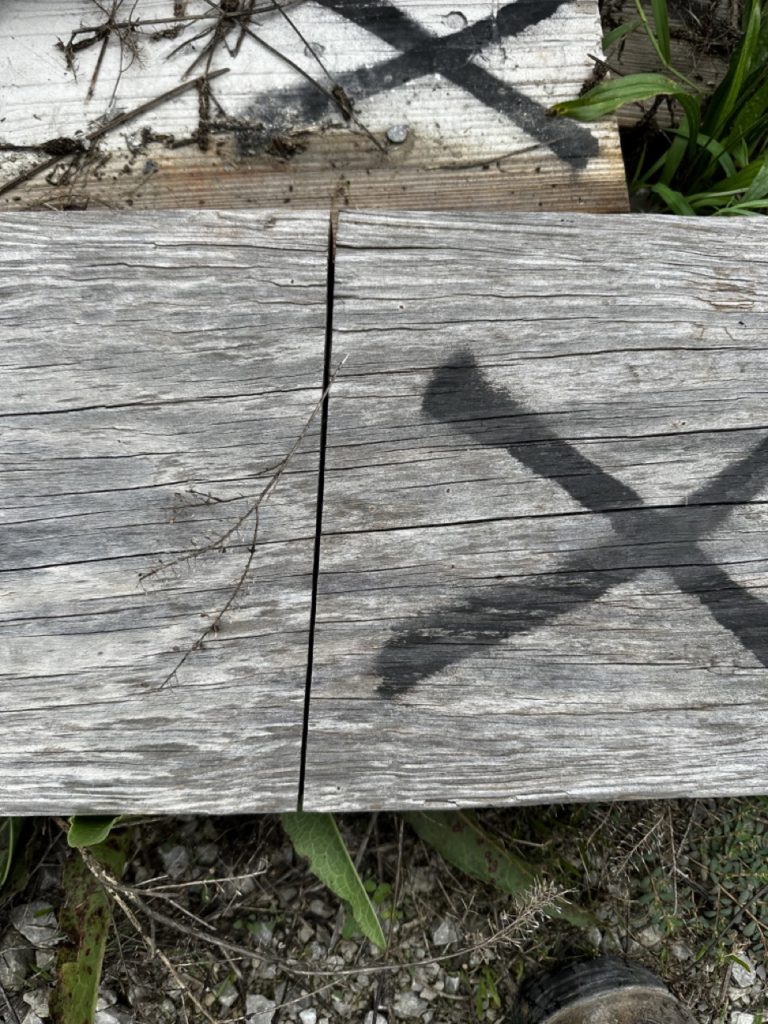 Figure 4B
Figure 4B7. Chemical contamination, rot from fungus/decay and insect damage must be removed from service.
CU Scaffold
Now onto the differences. I grew up on CU scaffold. I love CU scaffold. It is safe; assembled on the ground, all scaffold plank and fall protection are installed on the ground. Put it together correctly and it stays safe all of the way up the wall. It is productive; masons work at their most productive level without stopping to raise boards. It is versatile; built-in features to do cut up work productively better than any other scaffold available. It is affordable; less than half the price of mast climbers. It is a great everyman’s scaffold. It has many of the same characteristics of other scaffolding and a few differences.
Cables
CU is an elevated platform scaffold. The way it is elevated is by a cabled winch raising the platform. I feel the same way about cables as I do about scaffold plank - if you are scratching your head about whether something that is holding your life is good enough to use, it probably isn’t.
ANSI specifications require employers must replace wire rope (cables) when the following conditions exist:
- Kinks
- Six randomly broken wires in one rope lay or three broken wires in one strand in one lay
- One third of the original diameter of the outside wires is lost
- Any other physical damage that impairs the function and strength of the rope
Attention should be paid to systems that allow the cable to wrap over itself (Figure 5). Part of the cable hoist system is a cable head or hoist head. A damaged cable head should be replaced. The cable head should have the fasteners required by the manufacturer. If a pulley is used, inspect the pulley and replace it if damaged.
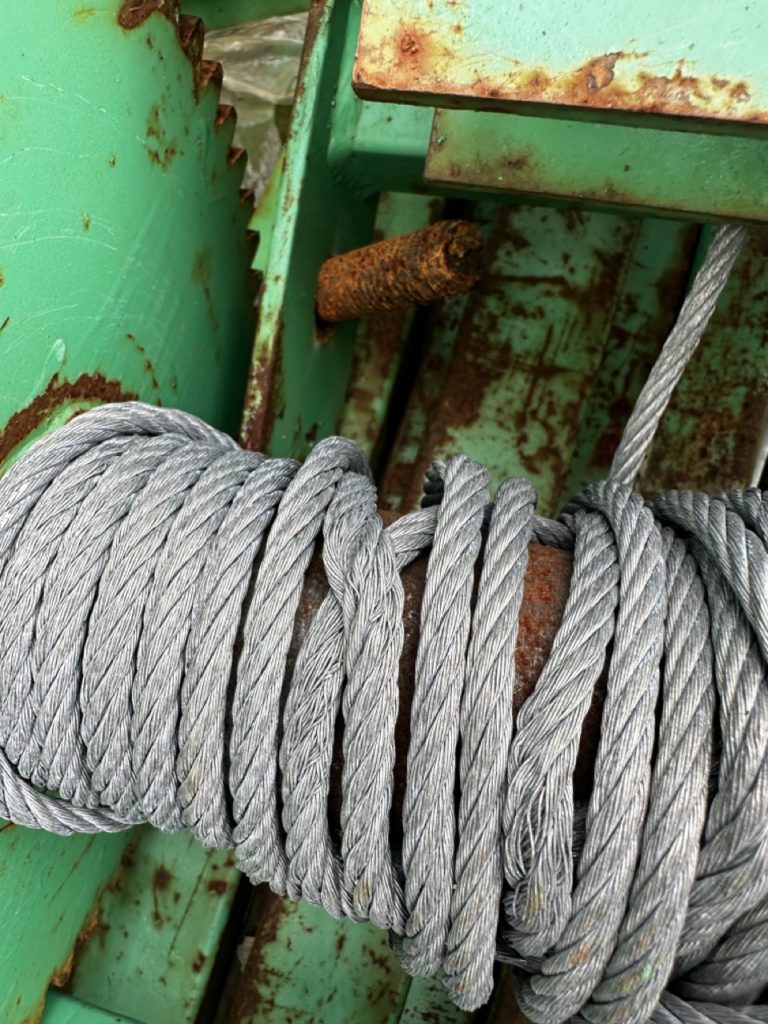 Figure 5
Figure 5Brace Locks
Inspect the brace locks. Make sure the welds are not damaged and the brace locks are operating properly and not damaged.
Freefall Dawg
Inspect the safety device that prevents uncontrolled downward movement (freefall dawg) (Figure 6). The safety device must operate freely and as designed. Examine for cracks. Damaged and inoperative safety devices must be removed from service.
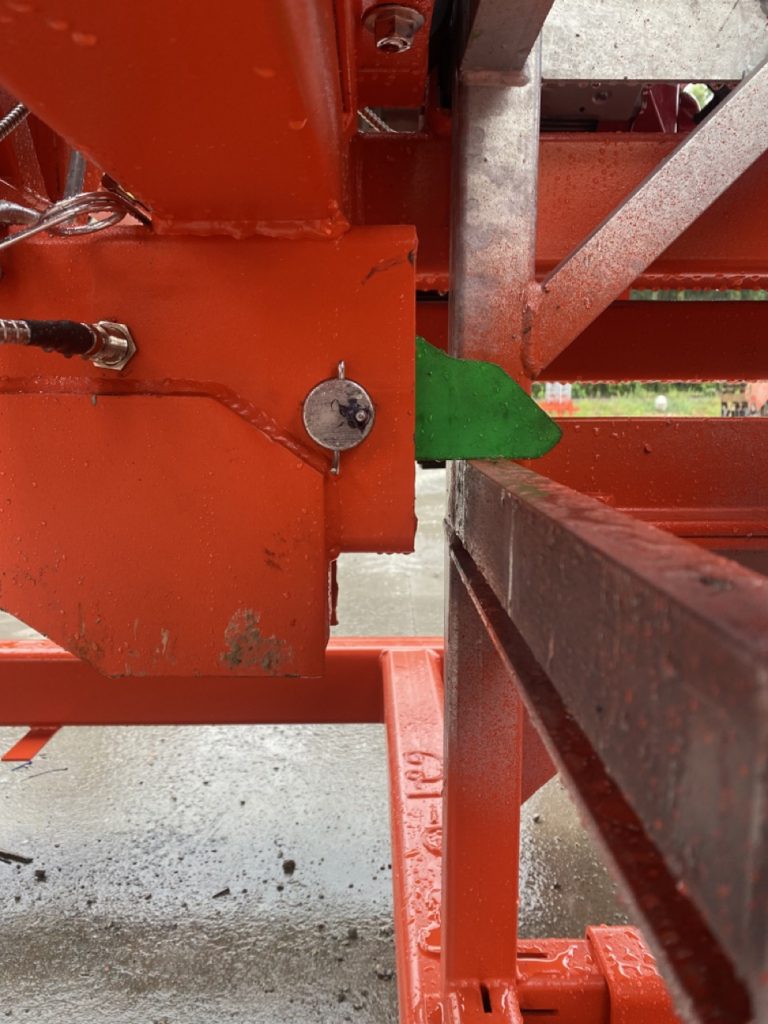 Figure 6
Figure 6Carriage Rollers and Winch Bushings
Inspect carriage rollers and winch bushings. Cracked or other damage to winch bushings can cause misaligned gears that may cause slippage or inconsistent wear. Carriage rollers that are not operating properly can cause the platform to bind up making the platform difficult to raise/lower or stop entirely. Replace damaged rollers/bushings.
Mast Climber Work Platforms
When we started designing a mast climber I thought we were spending a lot of money to push a button. Remember, I loved crank up (still do) but I was ignorant. Mast climbers are labor-saving, money-making machines. Employees love them because they are safer (easier access, less boards) and easier, a win-win. However, it is vital to properly maintain and inspect a mast climber to keep it safe and prevent shutdowns that interrupt production (similar to a forklift, mixer or pump).
According to ANSI 92.9, the standard for Mast Climber Work Platforms, frequent inspection should be performed on a unit that has been in service for three months or has been out of service for a period longer than three months. In addition to the frequent inspections every three months, an annual inspection is required within 13 months of the previous annual inspection. This must be done as specified by the manufacturer. All maintenance shall be performed by a qualified person in accordance with the manufacturer’s recommendations. Also, this is based on the environment and severity of use. More frequent maintenance may be required. All malfunctions and problems must be corrected before the MCWP is returned to service.
7.4.5 Frequent Inspection
The owner of a MCWP shall cause a FREQUENT INSPECTION to be performed on the MCWP:
The inspection shall be made by a person qualified on the specific make and model of the MCWP. The inspection shall include all items specified by the manufacturer for a FREQUENT INSPECTION and shall include but not be limited to the following:
a) All functions and their controls for speed(s), smoothness, and limits of motion.
It should operate just like new. Make sure operators communicate if it is making unusual noises or not operating properly. While the platform may still operate, it is a sign that something is wrong that may eventually shut the platform down or become dangerous. Fixing an MCWP that is not working properly keeps you working productively and safely.
b) Emergency lowering means. Not all mast climbers have emergency lowering devices.
c) All chain and cable mechanisms for adjustment and worn or damaged parts.
d) All emergency and safety devices.
Like the CU, inspect for smooth operation and any damage/cracks.
e) Lubrication of all moving parts, as specified by the manufacturer.
f) Visual inspection of structural components and other critical components such as
fasteners, pins, shafts, locking devices, bolts, nuts, and tie assemblies.
Parts and Components
According to ANSI 7.4.8 When parts or components are replaced, they shall be identical or superior to original MCWP parts or components. Be careful when choosing parts that are “superior”. Every bolt, nut and pin has been specifically chosen by an engineer and may not be “superior” for that intended use. The best rule is to get permission from the manufacturer when using an alternative.
g) Placards, warnings, and control markings.
h) Items specified by the manufacturer.
i) Correction of all malfunctions and problems identified and further inspection if necessary, before continuing use.
Documentation
Almost as important as inspection and maintenance is documenting. Whether it be a GC, OSHA or a lawyer, having proper documentation is essential. It’s as “if you don’t document it, you didn’t do it”. According to ANSI 7.5
The user shall retain the following records for at least four (4) years:
a) Name(s) of the operator(s) trained and retrained.
b) Names of operator(s) provided with familiarization.
c) The owner (or the entity designated by the owner) is responsible to ensure frequent and annual inspections are conducted and written records are maintained. The records shall include the date of the inspection, any deficiencies found, the corrective action recommended and identification of the person(s) performing the inspection. When the user accomplishes an inspection, they shall be responsible to ensure only qualified personnel inspect and that all such records are maintained for the four (4) years specified above.
d) When employees of the user accomplish repairs on the MCWP, the user shall maintain written records. The records shall indicate the date of the repair, a description of the work accomplished and identification of the person(s) performing the repair.
While it may seem that we don’t have the time to maintain equipment or it is too expensive to hire someone for maintenance, it is necessary. Not only is it required, but it is an important part of a profitable company. It is not a coincidence that the most successful companies have good maintenance programs. It is an important part of keeping your employees safe and productive and your company successful.